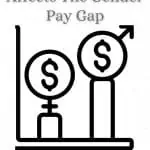How The Pandemic May Widen The Gender Pay Gap
If anyone has been reading the news lately, you’ll likely have noted that the number of layoffs in the month of December were well over 100,000. All of those were women. It’s so sad to think that despite the progress we’ve made, gender differences are still so starkly present. You can imagine how bad, then, the full 10 months of the pandemic have been so far for women, and as a result, for the gender pay gap going forward.
Read further on this guest post for how the current circumstances may result in a fall backwards in our progress.
The COVID pandemic has required us to socially distance and adapt our lifestyles. These adjustments caused a severe but a different kind of economic downturn. Working women have been adversely impacted compared to men, potentially stalling or reversing progress made over the past ten years. The gender pay gap may widen, causing long term financial consequences for women.
Ironically, 2020 was supposed to be the Year of The Woman to celebrate the 19th Amendment’s centennial anniversary of the right to vote.
Strides Women Have Made:
- Women have more degrees than their male counterparts.
- More than half of American jobs were held by women, with 51.8% in management, professional, and related occupations.
- In many professional fields, women’s pay has moved closer to being on par with men.
- Women-owned businesses represent more than 40% of all American businesses.
- Nearly 30% of heterosexual married women are breadwinners, excluding women who are the sole earners in their family.
Women Face More Trade-Offs Than Men
By pointing to the progress women have achieved, I don’t mean to imply it has been a cakewalk. Gender inequality, while diminished, remains with us.
Despite the strides made, many working women face different trade-offs than men. For instance, women often have to choose between career and family life; the jobs they choose are often through the lens of requiring flexibility to allow for continued caregiving responsibilities at home; despite their professional freedom, many women still don’t have separate financial accounts from their spouses.
These decisions are not new; however, generally speaking, men seldom have to make these trade-offs.
My experiences mirror those of most women. However, I will confess that I have an amazingly supportive husband, Craig, who recognized my career goals early in our marriage. While Craig was able to work from home for his lawfirm, I spent many successful years as a managing director for an investment bank. When we decided to have children, I decided to leave my lucrative career for more flexibility.
Having a spouse who shares equally in child care and household responsibilities alleviated my fears of leaving the job I enjoyed. Still, we needed a professional caregiver during the day to go to our careers or work remotely. We were fortunate that this arrangement worked well…until the pandemic.
The Pandemic Has Been Tougher On Women
COVID forced us to adapt to changes as we never have before. We had to be socially distanced, work from home, and take part in virtual schooling. Significant non-essential industries shuttered or curtailed operations. The pandemic affected women more harshly than men, causing higher job losses and higher unemployment rates for women.
How Women Are Being Professionally Affected By The Pandemic
Recessions are usually cyclically-driven, causing male-dominated industries like construction to contract more. While more men face unemployment in the typical downturn, the pandemic brought new vulnerabilities for women specifically, adding to existing imbalances.
1 – Women Have More Vulnerable Jobs
Women lost nearly 60% of the almost 700K lost pandemic-related jobs in March 2020. In April 2020, women’s unemployment rate reached 16.2% compared with 13.5% for men. Plus, women are continuing to leave the workforce at high numbers, with 865,000 gone in September alone. A July 2020 McKinsey study reported women made up 46% of workers pre-COVID of job losses, but 54% of overall job losses to-date.
Women’s higher job losses were because their jobs were 19% more at risk in sectors negatively impacted by the pandemic than their male counterparts. Those jobs–childcare day workers, home healthcare workers, cashiers, restaurant servers–became the most vulnerable to losing their jobs.
In addition, fewer women (22%) had jobs that allow for telecommuting than men (28%) in 2018. However, many companies allowed employees to work remotely for the first time as coronavirus became a more significant threat. Although women have sought more flexible work arrangements, the pandemic posed some unexpected difficulties.
2 – Tougher To Save For The Future
The National Women’s Law Center (NWLC) reported that women account for two-thirds of the 22.2 million workers in the US’s 40 lowest-paying jobs. Even if women are about half of the labor force, they have lower-paying jobs and tend to be less secure than men. More women than men are part-time workers (40% in 2019), which further drives down women’s earnings.
On average, lower-paid women who leave the workforce for child care and other responsibilities have had substantially lower retirement savings despite living longer. The pandemic will worsen these long-term repercussions for women’s financial security.
3 – The Fallback To Traditional Gender Roles
As businesses closed their offices, many families had to deal with both partners remotely working from home. That combined with school closings, the shift to virtual teaching, and the loss of professional childcare threw families into a quandary. In many cases, people reverted back to traditional roles. Many professional women found themselves working and being caregivers to their children, helping with homeschooling, and domestic housework.
As Gloria Steinem said,
“Women are not going to be equal outside the home until they are equal in it.”
According to an MIT study, 34% more American workers work from home for the first time due to the pandemic, adding to roughly 15% who had been working remotely pre-COVID. Of the new remote workers who began to work at the start of the virus, women were more likely to report they switched from commuting to work.
Increased flexible working opportunities should be good news for working women to improve their work/life balance well before the pandemic. However, studies assert that working from home often increases the household burden, even when both partners work from home. Yet, the burden is not shared equally amongst partners; rather the onus invariably falls on wives and mothers. Due to the pandemic, any additional help also became unavailable.
As a result, this led to many women to consider reducing work hours or leaving the workforce altogether.
4 – Stunted Career Growth
Working women have reduced their hours 4-5 times more than men, and some have lost their jobs. Instead of growing their careers, women are taking the fall to cope with their children’s and family’s needs. Other professional women working full time have left their jobs or are considering leaving their professions to find part-time employment to care for their kids.
For women, especially, leaving an excellent job is risky in this environment when there is high unemployment. With a tight job market, finding additional or alternative work on par with their skills may be a challenge. The loss of job experience also lends to a stunt in career growth. Often, women will find that they have to start over, or start several steps behind where they were when they go back into the work force.
This loss of experience can lead to lower paying jobs, and ultimately lower financial security in the future.
5 – A Disproportionate Struggle
Those that have continued on, for instance, women-owned businesses wherein that is the person’s livelihood, have a disproportionate struggle. Women have started and run their businesses at impressive rates. As owners, women have more flexibility, an income source, and control over their future. According to the latest data, the US had 12.3 million women-owned businesses that generated $1.8 trillion in revenue a year.
Businesses owned by women represented more than 40% of American businesses, which grew 21% in 2019. 62% of women entrepreneurs claim their business is their only income source. Yet, women are facing challenges to remain open during the pandemic. Small businesses especially have pressing financial needs which are typically more difficult for women than men. The average loan size for women was $38,942 versus $43,916 for men.
The Financial Fallout For Women
As mentioned earlier, this pandemic-related recession caused more significant unemployment in jobs typically held by women, such as retail, restaurants, hospitality, and homecare. This ultimately affects a woman’s financial future, leading to lower lifetime earnings, in several ways.
1 – The Gender Pay Gap
After the passage of the Equal Pay Act, the gender wage gap has narrowed significantly. Most recently, women were paid 81.5 cents to every $1 earned by men when looking at median hourly earnings without factoring in various compensable adjustments. However, the gender pay gap narrows when measuring salaries based on the same job and qualifications and could be as high for women as men at $0.98 to $1. According to a recent Payscale study, the pay gap varies by field.
Penalties For Leaving Your Job
Women who have left the workforce during the pandemic may find it hard to return to the same job at the same wages. Research has shown women may have to absorb penalties of 7% on average despite their prior salary history. This penalty will worsen the gender pay gap in the long term, making it harder to catch up, leading to fewer savings and a smaller retirements.
2 – Social Security Benefits
Women are less likely than men to have employer-provided pension plans, making them more reliant on social security, which is inflation-adjusted. As such, 48% of elderly unmarried women receiving social security checks relied on it for 90% of their total income.
Yet, when women earn less, it impacts their social security benefits causing lower payments. In 2017, the monthly social security monthly benefits of a retired woman were $1,196 compared to $1,503 for men.
3 – Gender Retirement Gap May Widen
Women face significant financial shortcomings. The cumulative factors of lower pay, time out of the workforce for child care, and unpaid family caregiving have ripple effects causing a wide gender retirement gap.
A 2018 analysis of Vanguard’s defined contribution retirement plans highlights the gender difference. Men accounted for 60% of the plan’s participation, with median account balances of $27,030 versus $17,620 for women. When compounding over 35-40 years, these lower amounts create huge disparities over time for women who live longer.
Positive Developments On Retirement Savings
On the positive side, a more recent Vanguard analysis revealed that the adoption of automatic enrollment to company-sponsored 401K plans has been rising, particularly for women who earn less than $100,000. Their participation is between 11%-17% higher than men and may help mitigate the retirement savings gap for women. More companies are allowing part-time workers, predominantly women, to participate in their 401K sponsored programs.
In Summary
Gender equality begins when females can have similar job and career opportunities as their male counterparts that are also compensated on the same level. The strides we’ve made over the years are being canceled out due to the pandemic.
It may take years to analyze the larger pandemic effects on women thoroughly. Women had more exposure to lower pay, job losses associated with more vulnerable industries, reduced hours, and more likely as parents to have household and child care responsibilities. By leaving their jobs and careers in 2020 and 2021, women may have a more challenging time returning to their employment at similar salaries.
These cumulative factors may widen the existing gender pay gap and retirement gap making it harder to bounce back.
Share your comments and stories below! Images courtesy of flaticon






